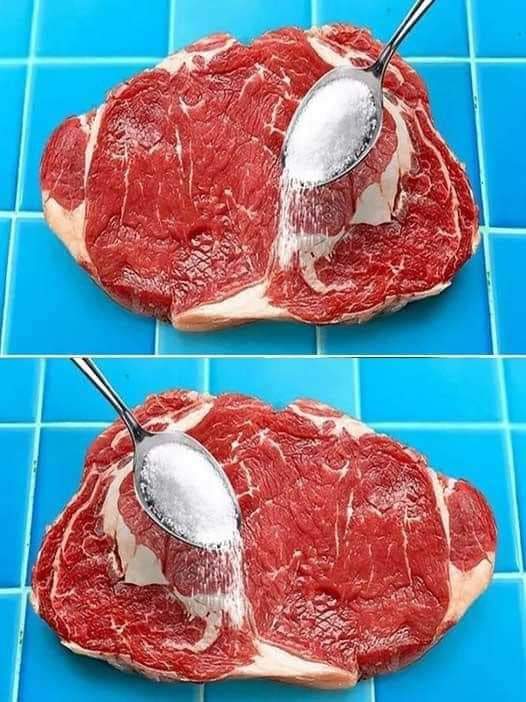ADVERTISEMENT
Instructions:
- Prepare Your Steak
Start with a steak that is fresh or properly thawed if frozen. Pat the steak dry with paper towels. This is crucial because excess moisture on the steak’s surface can interfere with seasoning and searing. You want the surface of the steak to be as dry as possible for a good sear. - Salt the Steak Generously
Rub kosher salt all over the steak. The salt acts as a natural tenderizer, drawing moisture out and then reabsorbing it along with some of the salt, which helps to break down the meat’s proteins. Be sure to salt the steak at least 30 minutes before cooking—or even better, a few hours prior. This resting time allows the salt to penetrate the meat, helping to tenderize it. - Create a Savory Rub
While the salt is working its magic, mix together the black pepper, garlic powder, onion powder, and dried rosemary (or thyme). This combination of seasonings will not only enhance the flavor of the steak but also contribute to the tenderizing process. Apply the rub evenly over the steak, pressing it gently into the surface. - Massage the Oil Into the Meat
Drizzle the olive oil (or melted butter) over the steak and massage it into the meat. This helps to distribute the rub evenly and adds a rich flavor and moisture that will complement the tenderness achieved through salting and resting. - Let It Rest
Now, here’s the key to the tenderization process: let your steak rest! Allow the seasoned steak to sit at room temperature for at least 30 minutes, or even longer if possible (up to 2 hours). The salt will continue to penetrate the meat and break down the fibers, making it more tender. During this time, you can also prepare your sides or heat your grill or pan for cooking. - Optional: Add Acid for Extra Tenderness
If you really want to take the tenderness up a notch, you can add a small amount of acid—like a squeeze of lemon juice or a splash of vinegar—just before cooking. The acid helps to further break down the muscle fibers in the meat. If you’re using an acidic marinade, make sure not to marinate the steak for too long—around 30 minutes to an hour is ideal to avoid making the meat mushy. - Cook to Your Desired Doneness
Once the steak has rested, it’s time to cook it! Whether you’re grilling, pan-searing, or broiling, make sure your pan or grill is preheated to high heat before placing the steak on it. Cooking on high heat helps seal in the juices and gives you a delicious crust on the outside while keeping the inside tender and juicy. Depending on the thickness of the steak, cook it to your preferred doneness, whether that’s rare, medium-rare, or well-done. - Let the Steak Rest Again
After cooking, let your steak rest for a few minutes before slicing into it. This allows the juices to redistribute within the meat, making it even more tender and juicy when you cut into it. - Slice and Serve
When it’s time to slice, be sure to cut against the grain (the direction the muscle fibers run) to maximize tenderness. The shorter muscle fibers make for a more tender, easy-to-chew steak.
Tips for Perfect Steak Tenderization
- Don’t Skip the Resting Time: While it may seem tempting to cook right away, giving the steak time to rest and absorb the salt and seasoning is crucial for achieving that tender, flavorful result.
- Choose the Right Cut: While this tenderizing method works on all cuts of steak, it’s especially effective for tougher cuts like flank, skirt, or round steak. For naturally tender cuts like ribeye or filet mignon, this method can enhance the flavor but isn’t strictly necessary.
- Use Kosher Salt: Kosher salt is preferred for tenderizing because of its larger crystals, which help draw moisture out more effectively than regular table salt.
- Don’t Overcook: Overcooking a steak can make it tough, no matter how much tenderization you do beforehand. Use a meat thermometer to check for your desired doneness and avoid drying out the steak.
Why This Method Works
This savory tenderization method works because it combines several key elements that break down the meat’s tough fibers. The salt draws moisture out, then reintroduces it, making the steak juicy and tender. The oil or butter creates a protective layer, keeping the steak moist during cooking. The seasonings provide an additional layer of flavor that complements the meat’s natural taste. Together, they create the perfect steak—tender, flavorful, and absolutely mouthwatering.
Conclusion
Whether you’re an experienced grill master or someone new to cooking steak, this savory steak tenderization method will elevate your steak game and ensure a melt-in-your-mouth experience every time. It’s simple, effective, and requires just a few key ingredients. The result? Perfectly tender steaks that are bursting with flavor, ready to impress your family or guests on any occasion.
Ready to tenderize your steak like a pro? Give this method a try and prepare to fall in love with every juicy, flavorful bite!
ADVERTISEMENT
